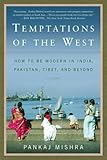Reading Pankaj Mishra is often a repetitive experience where he is constantly poring over the facets of India that he chooses to look at a given point in time from a perspective that always sees the glass as half empty. I have read two of this works before, “Butter Chicken in Ludhiana: Travels in Small Town India” and “The Romantics: A Novel” before getting my paws on “Temptations of the West: How to Be Modern in India, Pakistan, Tibet, and Beyond”. All three books have the common thread of 'everything sucks' and the constant search of a life that exists only in his memories and a time long gone.
Frankly, it is easy to get depressed and suicidal if you read three of his books in a row. They show a world that is full of poverty, ugliness, near-zero happiness and all wrong things. Even though 'Temptations' is a work of non-fiction, gleaned from the expansive travelling Mishra has undertaken in the subcontinent, the book has a texture to it that is very fictional. It is amusing that when he writes fiction, the writer has so much of his own life in it that it looks like non-fiction and when he writes fiction, it reads much like fiction. What a predicament.
That said, the book is his strongest work of the three. It paraphrases his travel through India, Pakistan, Afghanistan, Nepal and Tibet from 2000. It is an interesting and captivating read, even after accounting for his constant obsession with the caste system and religious divides almost everywhere. He does touch on a variety of controversial topics — from killings and torture in Kashmir to muscle and money power in Indian politics — and spices up the narrative with a generous sprinkling of facts and anecdotes.
At close to 500 pages, the book does require you to spend some time with it. But Mishra's text is simple and he does not use the power of language to keep things away from everyone. If nothing else, the book is an interesting read to contrast the different Indias that we know of: the one reported in Indian media, the one that the West gets to see and the day-to-day India that most of us Indians live with at ground zero.
